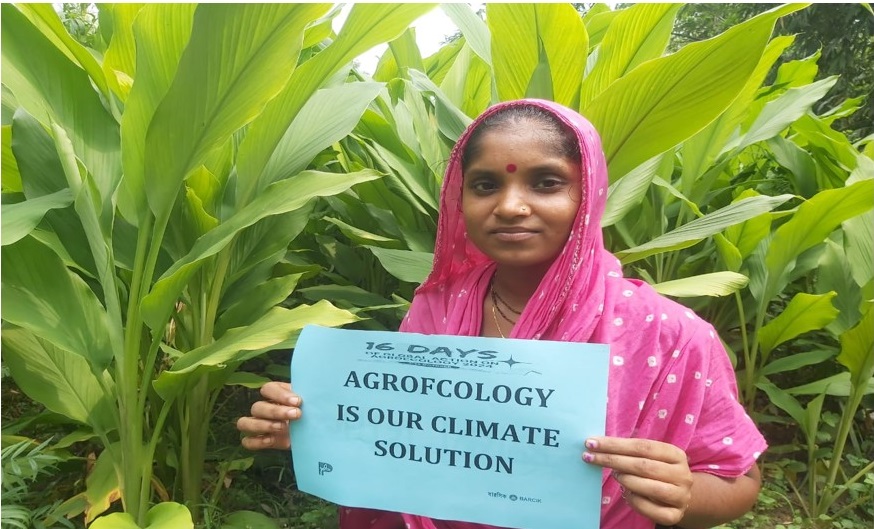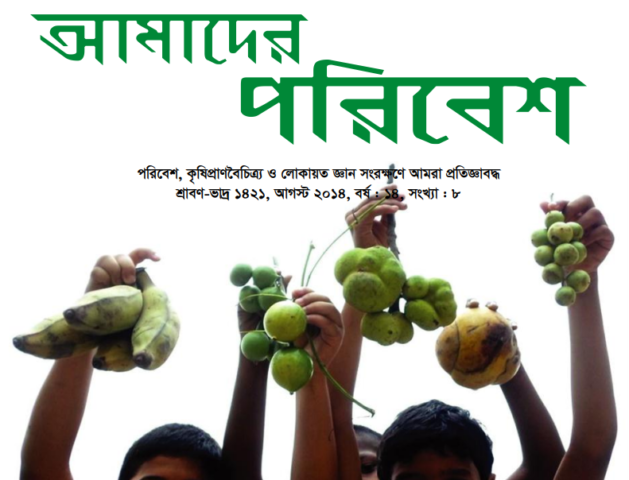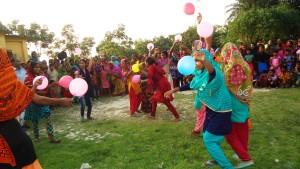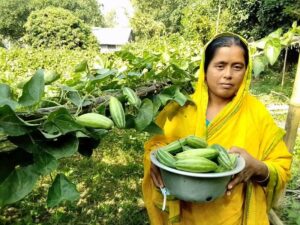Pavel Partha and Silvanus Lamin
Introduction
Climate change is one of the major threats which poses risks and problems to the people in Bangladesh. Despite producing only 0.56% of the global emissions, Bangladesh ranks22 7th on the list of countries most vulnerable to climate devastation, according to Germanwatch’s 2021 Global Climate Risk Index (CRI). Due to climate change and other human induced causes, including people in the country the target areas are hit by frequent disasters such as floods, cyclone, thunderstorm, riverbank erosion etc. Climate induced disasters such as floods, drought and cyclones damage the country’s physical infrastructures, crops, lives and livelihoods accelerating its vulnerability and creating economic loss. According to a report, from 2000 to 2019, Bangladesh suffered economic losses worth $3.72 billion and witnessed 185 extreme weather events due to climate change. Furthermore, a U.S. government study report states that 90 million Bangladeshis (56 percent of the population) live in “high climate exposure areas,” with 53 million subjects to “very high” exposure. However, Satkhira district is located in the coastal region of Bangladesh. It is a unique and vibrant area characterized by its rich biodiversity, cultural heritage, and economic significance. The Sundarbans, the largest mangrove forest in the world and is located in this area and is home to the famous Bengal tiger, along with numerous other species of flora and fauna. Satkhira, faces the dual challenges of salinity intrusion and frequent cyclones, which significantly hinder agricultural activities. It is highly susceptible to climate change-induced disasters, affecting not only agriculture but also fisheries, aquaculture, and tourism, thereby threatening the livelihoods of the local population. However, in spite of those challenges the community people in this area, particularly women have been practicing local led adaptation in agriculture to reduce their loss, improve their livelihood status and uphold their existence. BARCIK has been facilitating development intervention in the area since 2001 and has been documented the adaptation practices, in some cases mitigation initiatives of the coastal communities which help them coping with the climate induced disasters. Nonetheless, the people in the coast generally depend on agriculture for their livelihood. The farmers of the area produce rice, vegetable and other crops to earn their livelihood. BARCIK has documented the stories of 60 women in 10 villages of Satkhira districts who have been practicing environment friendly cultivation systems to produce crops in their lands and homestead gardens. These women prepare organic fertilizers and pesticides by themselves and apply in their crop lands. They conserve seeds and are engaged in participatory action research to select climate tolerant varieties of rice and other crops from the native ones. They cultivate diverse varieties of crops to ensure their food security. These women also use their indigenous knowledge to adapt to climate change by practicing crop rotation, mulching, cultivating vegetable using sacks, and using surface water to irrigate their crops etc. By adopting this environment friendly way of crop cultivation these women have been able to improve their livelihood status enabling them to cope with the changed situation occurred due to climate change.
Methodology
The methodology employed in this article is comprehensive and multifaceted, ensuring a strong collection of information regarding the coastal region of Bangladesh. The approach is divided into two main categories: primary and secondary data collection. Primary data has been collected through a series of focus group discussions, structured meetings and interviews with various stakeholders, community leaders, and representatives from non-governmental organizations (NGOs). In addition to general interviews, key informant interviews were conducted with individuals who possess specialized knowledge or experience related to the coastal ecosystem, economic activities, and environment. Secondary data were collected through reviewing literatures. This involved analyzing a wide range of sources, including newspapers, scholarly articles, and books available on the internet. Secondary information was also extracted from reports published by BARCIK and other NGOs. Websites and online resources were utilized to access relevant documents and reports. Once the data was collected, a systematic analysis was conducted to identify patterns, themes, and correlations within the information gathered. This involved qualitative analysis techniques to interpret the insights from focus groups and interviews, as well as quantitative methods where applicable.
Result with analysis
With an underlying objective of reducing risks and vulnerabilities to climate change impacts, the national adaptation plan of Bangladesh envisions to build a climate-resilient nation through effective adaptation strategies that foster a robust society and ecosystems and stimulate sustainable economic growth. BARCIK, a non-governmental organization has been working to build a climate resilient society through promoting and advancing agroecology, which includes nature based and organic. To encourage the farming community adopt agroecology, BARCIK advises farming communities conserving native seeds, use of organic manure and bio pesticides and biodiversity conservation to counter climate change effects. Due to this mobilization and encouragement today the farming communities of one of the areas in the coastal region has started to yield some benefits. While working to promoting agroecology BARCIK always involves the local farming organizations in the process and takes initiatives to develop the capacity of the members of those organizations on different thematic issues including sustainable agriculture principles. Hence, through the joint initiatives of BARCIK and farming communities farmer’s led applied research was conducted to select climate adaptable crops varieties as well as conserve the almost extinct native varieties. The farming communities through their efforts and BARCIK’s supports conserve seeds and biodiversity and selected climate adaptable (Saline tolerant, deep water rice) varieties. The farming community, particularly women have been able to cope with climate induced disasters through adopting the principle of agroecology. They also apply their indigenous knowledge and innovations in coping with these climate induced disasters. They cultivate crops through elevating beds in water logging and flooding situation. Some of them use sacks and racks to cultivate crops during floods adopting organic methods. The overall initiatives of women farmers with the facilitating supports from BARCIK plays significant role to increasing crop diversity, agricultural produces and seed diversity in the area and increase their climate resilience. Below are some climate change adaptation practices of some women in the coast that enable them to produce crops to improve their livelihood status and ensure food security of their family including earning cash that elevates their social status fostering their empowerment.
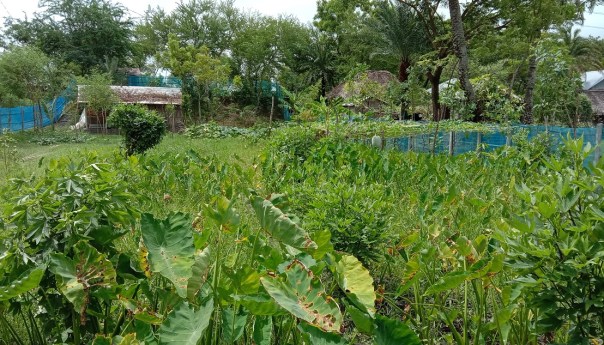
Agroecological practice enhances climate resilience of women in the coastal region. The women in the coast have been benefited farming crops and yield success through adopting agroecology. Aditi Rani (44) is one of the women in the region who has been benefited from agroecological practices. Living at Kalmegha village in of Shyamnagar Upazila in Satkhira she has been contributing to restoring biodiversity of the region through her agriculture practice. She plants diverse vegetable, spinaches and native fruits, woods and medicinal trees in her homestead land. She produces vegetable and crops using compost and vermicompost in her lands. At the same time, she uses organic pesticides and sex pheromone trap technology to suppress crop pests. While interacting with her she state that, ‘I conserve the seeds of all the crops that I grow every year. I can even produce crops in spite of different climate disasters. I provide technical support to others in making vermicompost. I received technical support from BARCIK to continue practicing agroecological practices.’ However, being inspired by Aditi Rani Chakina Begum of Kochukhali, Sujata Barman of Paschim Jelekhali and Rozina Begum of Purchekhali villages are vibrant characters in the area in term of agroecological practices who have improved their livelihoods through cultivation of diverse crop without harming the nature.
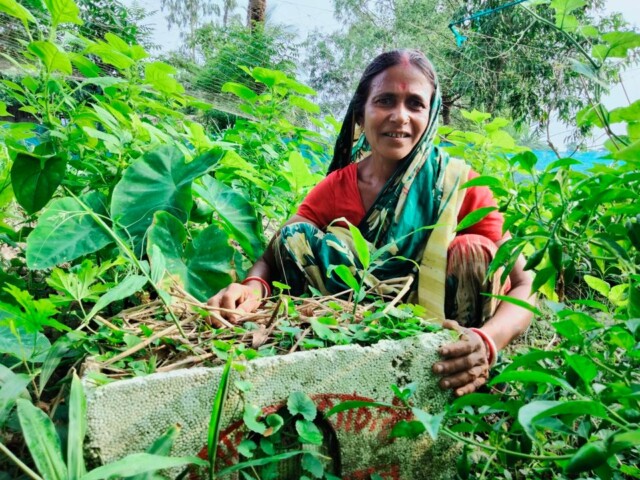
On the other hand, agroecology inspires nature-Based agriculture and this nature-based agriculture sustains livelihoods and the environment. It fosters the conservation of biodiversity through harnessing naturally grown uncultivated plants. Parul Rani (36) of Borokupot village of Shymnagar in Satkhira has been practicing nature based farming for a long time being supported by BARCIK. This enables her to adapting to the climate induced disasters. She inherited this sort of nature based food production system from her ancestors. She produces vegetable in her homestead land in different seasons through the year. Parul Rani said, ‘I try to maximize the use of my lands by growing crops and vegetable throughout the year adopting nature based agriculture. I farm all kinds of vegetables in my lands prioritizing my choice. Since I do not use chemical therefore, I contribute to keeping the environment and nature alive and healthy.’ Including Parul Rani Arpita Rani of Purba Jelekhali, Purul Mondal of Paschim Dhankhali and Sazida Begum of Kalinagar villages of Satkhira enriched their lands with diverse crops and plants. This rich biodiversity has contributed to protecting and conserving the agricultural heritage, culture and sustainable livelihood of the coast. This nature based farming has also enabled these women to produce crops in spite of being hit with frequent disasters.
Furthermore, being capacitated on the practices of agroecology some women in the coastal region have applied their innovation to cope to climate change. We know that saline water intrusion after cyclone, unplanned expansion of shrimp farming using saline water and water logging forced many farming families to abandon agricultural production in the coast. But some women in the coastal region have found some ways to solve their climate change related problems using their indigenous knowledge, observation and experiences. Anita Rani Mondal (41) of Betangi village in Shyamnagar upazila of Satkhira district is one among these women. She realized when saline water evaporates; it leaves excess salt in the soil, increasing the salt concentration every day. To avoid salinity contamination she used to sow the seeds in the gunny bag, sacks and concrete pots etc. She has been using cork boxes to grow vegetable as gunny bags are not as durable as cork boxes. Cork boxes are available because there are many shrimp farms-which use it for carrying shrimp fry from market to farms. Anita found difficulties due to regular natural disasters like heavy rain inundated her court yard that made gunny bags unusable. She come into a new idea and developed the new strategy using cork boxes instead of gunny bags for growing vegetable round the year even her courtyard inundated. This is how Anita Rani has been successful in adapting to climate change situation and finds local solutions to climatic problems. She said, “I have used my observation to cope with the climate related problems and now have been able to produce crops in spite of the salinity. Now I am supporting my family and my children’s education by selling vegetables.”

Seed conservation, multiplication and seed exchanges part of agroecological practices. Actually, the culture of seed conservation and exchange has faded away in coastal area due to natural disasters and practice of modern agriculture. However, agroecological practices have revived the culture of seed conservation and exchange farmers. Some farmers, particularly women in the coastal region of Bangladesh still adopt sustainable agriculture and try to bring back rich agriculture tradition and heritage of the coast through conserving and protecting the native seeds ensuring seed diversity in the area. Alpana Rani Mistri is one among the farmers. In her yard different types of vegetable seeds are kept in different containers. Her initiative to conserve seeds and practice sustainable agriculture has attracted the attention of other farmers. Alpana Rani Mistry said, ‘we are losing local seeds due to climate induced disasters and high prevalence of hybrids.’ According to her, native seeds and biodiversity conservation will keep the coast safe and this will enable farmers to find varieties which are resistant to climate stress. Lakshmi Rani Mandal of Badghata, Rabeya Parveen of Antakhali, and Madhuri Sarder of Mothura villages of Shyamnagar upazila in Satkhira also collect, conserve and exchange native seeds among others to contributing to restore the seed diversity of the coast.
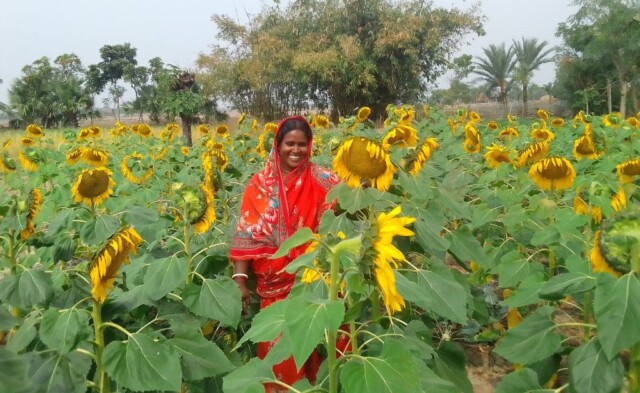
Agroecology shows the way to grow diversified vegetables in an environment friendly manner. BARCIK promotes agroeclogical practices to ensure that consumers have safe foods in their hands. The food grown through environment friendly farming contains nutritional value as well since external inputs (Chemical fertilizers and pesticides) are not used. To advance the agroecological practices among farmers BARCIK has developed ‘Nutrition Bank Model’ among rural women. Apart from this, these women also facilitated to consider safe food and gender aspect of the food. Nonetheless, through this model BARCIK selected and facilitated 400 houses in its 4 working areas. Famers, particularly women are encouraged to maximize their courtyard, adjoining area of their house for food safe food production adopting the principles of agroecology in farming. They are encouraged to organize courtyard meetings and discussions and conduct movements to fight for their rights. However, Neela Rani (45) of Abad Chandipur village of Satkhira has developed her house as an integrated agricultural farm being inspired from the Nutrition bank model. She cultivates various types of vegetables and crops. All kinds of vegetables and crops are produced through intensive cultivation and care in an environment friendly manner without using external inputs. Neela Rani said, “If you produce diverse crops it enables you to have nutritious foods. Consuming nutritious foods helps to increase our health immunity.” Dipali Rani of Kholpetua River in Sadar Union of Satkhira also practices agroecology to improve her livelihood and ensure nutrition foods for her family members. Alike Neela Rani and Dipali Rani, Kohinur Begum of Sonamugari, Delowara Begum of Badghat, Koruna Rani of Betangi, Shefali Begum of Datinakhali and Nilima Rani of Arpangashia have been able to produce vegetable ensuring safe foods for family members coping with the climate change situation through adopting agroecological practices.
Conclusion
Bangladesh is one of the most vulnerable countries to climate change. The adverse effects of climate change have a devastating effect on agriculture, tourism and aqua culture of Bangladesh leading the farming communities facing immense problems in food production. However, some Bangladeshi women communities have developed indigenous knowledge based agricultural adaptation strategies to cope with climate variability and extreme events. These women have been able to cope with climate induced disasters through intensive practicing agroecology that include using organic fertilizers, pesticides, involving in applied research to select climate tolerant rice and crop varieties and planting diverse crops, practicing crop rotation etc. Additionally, they have been successfully applying their indigenous knowledge and innovations in coping with climate extreme through practicing crop farming in sacks, boxes and elevating beds as well as using cork boxes. These practices should be expanded and shared among other communities in other areas and encourage them to replicate these in their perspective areas to cope with climate induced disasters. However, some of these practices may need to be adjusted to face additional climate risks associated with climate change. The major constraints to applying agricultural adaptation practices in Bangladesh is lack of knowledge, expertise and data on climate change. Therefore, in order to minimize the gaps in knowledge and expertise it needs to further develop the capacity of the farming communities and enhance their knowledge through conducting trainings and fostering more research works. Furthermore, initiative needs to be taken to improve and strengthen human capital, through education, outreach, and extension services, improves decision-making capacity at every level and increases the collective capacity to adapt to climate change.
Information sources
- https://www.climaterealityproject.org/blog/how-climate-crisis-impacting-bangladesh
- https://www.climaterealityproject.org/blog/how-climate-crisis-impacting-bangladesh
- FRAGILITY AND CLIMATE RISKS IN BANGLADESH, 2018, USAID)
- National Adaptation Plan of Bangladesh (2023-2050)
- BARCIK annual progress report

